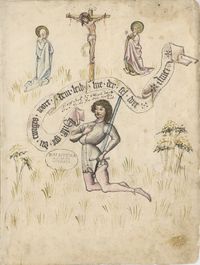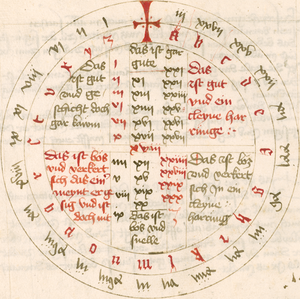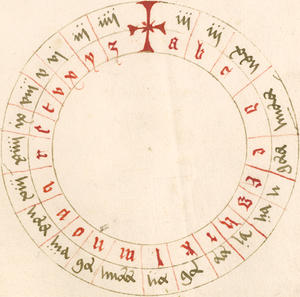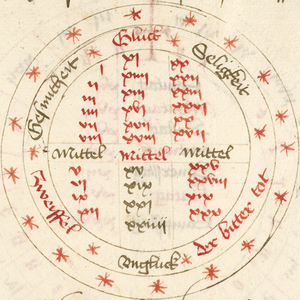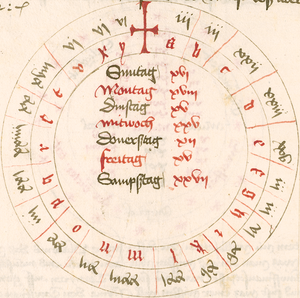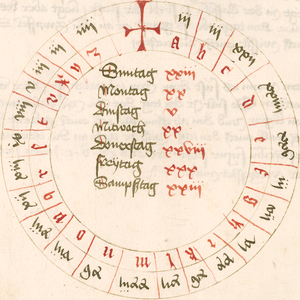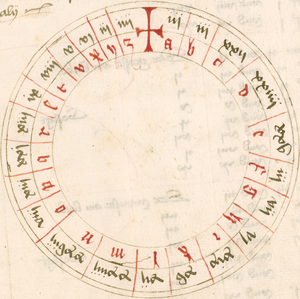|
|
You are not currently logged in. Are you accessing the unsecure (http) portal? Click here to switch to the secure portal. |
Difference between revisions of "Johannes Hartlieb"
| Line 34: | Line 34: | ||
| [[Talhoffer Fechtbuch (MS Chart.A.558)|MS Chart.A.558]] (1443) | | [[Talhoffer Fechtbuch (MS Chart.A.558)|MS Chart.A.558]] (1443) | ||
| [[Talhoffer Fechtbuch (MS 26.236)|MS 26.236]] (1500s) | | [[Talhoffer Fechtbuch (MS 26.236)|MS 26.236]] (1500s) | ||
| − | | [[Talhoffer Fechtbuch (2º | + | | [[Talhoffer Fechtbuch (2º Col.MS.Philos.61)|2º Col. MS philos. 61]] (1600s) |
| [[Talhoffer Sammelhandschrift (2º MS iurid. 29)|2º MS iurid. 29]] (1600s) | | [[Talhoffer Sammelhandschrift (2º MS iurid. 29)|2º MS iurid. 29]] (1600s) | ||
| [[Talhoffer Fechtbuch (Cod.icon. 395)|Cod.icon. 395]] (1820) | | [[Talhoffer Fechtbuch (Cod.icon. 395)|Cod.icon. 395]] (1820) | ||
Revision as of 20:13, 15 May 2018
| Johannes Hartlieb | |
|---|---|
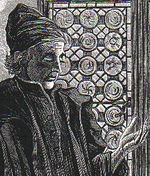 | |
| Born | ca. 1410 Ludwigsburg |
| Died | 18 May 1468 |
| Spouse(s) | Sibilla Bernauer |
| Occupation | Physician |
| Education | Doctor |
| Alma mater | University of Padua |
| Notable work(s) | Ueber die Erhaltung des Sieges |
| Manuscript(s) |
2º Col. MS philos. 61 (1600s)
|
Johannes Hartlieb (ca. 1410 - 18 May 1468) was a German physician, poet, and author, probably of a family from Neuburg an der Donau. By 1436 he was serving as parish priest of St. Moritz in Ingolstadt, but was removed in 1437 by Louis VII of Bavaria for neglecting his duties (he seems to have been in Vienna at the time). In 1439, Hartlieb received a doctorate in medicine from the University of Padua, and in 1440 he entered the service of Albert III of Bavaria. He would go on to serve Albert's son Sigismund as well (beginning in 1456). In 1444, he married Sibilla, daughter of Agnes Bernauer and (allegedly) Albert III, and ultimately they had three children together.
Hartlieb was an acquaintance of German fencing master Hans Talhoffer, and in February 1436 wrote him a letter suggesting a solution to the Villenbach case that Talhoffer had become enmeshed in.[1] Talhoffer went on to include a copy of Hartlieb's 1436 treatise Ueber die Erhaltung des Sieges ("On the Preservation of Victory"), which covered techniques of onomancy (divinations based on a subjects name) that could be used to determine the winner in a fight, in his own personal manuscript of 1443 (MS Chart.A.558).
Hartlieb also wrote a number of other treatises in his life on herbalism and various esoteric subjects, and seems especially to have had a fascination with magic. Early in his life this had a more positive cast, while his later works approach the subject with a more religious disapproval. As none of these texts are related to any extant fencing manuals, they will not be discussed here.
Contents
Treatise
Images |
Incomplete Translation |
Transcription | |||||||||||||||||||||||||||||||||||||||||||||||||||||||||||||||||||||||||||
|---|---|---|---|---|---|---|---|---|---|---|---|---|---|---|---|---|---|---|---|---|---|---|---|---|---|---|---|---|---|---|---|---|---|---|---|---|---|---|---|---|---|---|---|---|---|---|---|---|---|---|---|---|---|---|---|---|---|---|---|---|---|---|---|---|---|---|---|---|---|---|---|---|---|---|---|---|---|
Firstly we must remark that the entire art of winning depends on the day which belongs to the combatant determined by the name he bears. You must know that almost all the great masters have ordinarily categorised names in two lists: the fist contains the names which are consecrated to the Our Lady, the Virgin Mary; the other to saint George. So that all names belonging to Our lady, in other words that are on her list, are called brothers of Our lady, and those which are found in the group consecrated to saint George, are called by them the brothers of saint George. Also, you should know that all the names which belong to the brothers of Our Lady obtain complete victory three days of each week and Sunday afternoon. Likewise, the brothers of saint George obtain complete victory three days of each week and Sunday morning (before noon). |
[7r] AN dem ersten ist zu mercken das alle kunst des gesigs ist an dem tag der einem ÿtlichem namen zügehört / Wisßet auch das die hohen meister alle gemeinglich die namen geteÿlet haben In zweÿ teyle / Den ersten vnnser frawe~ namen der Junckfraw marie zugehört / Vnd den anderñ teyle sant Jorgen Also welcher name vnnßr frawen zugehört der an Irem teÿl stet den heyßen sie vnßr frawen bruder / Vnd welcher an sant Jorgen teÿle stet / den heißen sie sant Jorgen bruder bruder sind Daraüff wisßet alle namen die vnnser frawen brüder sind haben dreÿ tag In einer ÿtzlichen wochen gantzen sygk Vnd den Süntag / nach mittag So haben sant Jorgen brüder aüch dreÿ tag in einer itlichen wochen gantzen sygk vnd den Süntag vor mÿttage :• | ||||||||||||||||||||||||||||||||||||||||||||||||||||||||||||||||||||||||||||
Tuesday, Thursday and Saturday, and the afternoon of Sunday are to the brothers of Our Lady. |
Item der Eritag Pfincztag / vnd Sampßtag vnd der süntag nach mÿttag gehört vnnser frawen brüder zü | ||||||||||||||||||||||||||||||||||||||||||||||||||||||||||||||||||||||||||||
Mondays, Wednesdays, Fridays, and before noon on Sunday belong to the brothers of Saint George. |
Item der montag Mitwochen freytag vnd suntag vor mittag gehört sant Jorgen zü | ||||||||||||||||||||||||||||||||||||||||||||||||||||||||||||||||||||||||||||
Now, one must know, when one provokes with the will to fight he must first make sure to start on his day, and make sure that the one who writes his letter of provocation is his brother, as well as the person who will deliver it, and that it is also their day. If he does this there is no doubt that the victory and advantage will be his. He should be careful not to mistaken the day, or miss it. |
NV ist zu wisßen wenn einer aüsspricht vnd mutwilt ist es zü dem ersten So sal er gar wol mercken das er an seinem tag an hebt vnd der schreiber der den brieff schreibt aüch sein bruder seÿ Vnd der bote der den brieff tregt aüch sein bruder seÿ Vnd auch an seinem tag seÿ der Im zü gehört vnd thut er das so ist er an allen zweiffel sicher das er den sygk hat vnd gewyñet Er sal sich auch der sache fleisßen / Das er keinen tag / ver czele ader vberhüpff | ||||||||||||||||||||||||||||||||||||||||||||||||||||||||||||||||||||||||||||
Item… we also have to remark that if someone provokes his brother in name on a day which belongs to both, it will be the person who provokes that will have the advantage. But if one of the two absolutely wants to risk fighting his brother, he should choose the days which does not belong to him; for example if he is a brother of Saint George and he wants to fight against another brother of Saint George, he should begin the preliminaries on a day which belongs to the brothers of Our Lady, for example Tuesday, Thursday, and Saturday, and on the same day he should send the message or answer it. |
Item mer ist zu mercken Welcher bruder seinen bruder anspricht an dem tag der In beyden zü gehört das der anclag° nyder liegt an allen zweiffel mag es aber einer nicht vertragen gesein Er wölle ye mit seinem bruder mütwillen So sal er die anderñ tag die Im nicht zugehören erwelen als [7v] Wer es sant Jorgen bruder / Vnd welet er aber mit mutwilln der aüch sant Jorgen bruder wer / so sal er aüch alle sein sache an vahen an dem tage dÿ vnnser frawen bruder zügehören / als am Eritag pfincztag samßtag vnd sal in gleicher maße thün als am tag mitschreiben vnd mit antwürten | ||||||||||||||||||||||||||||||||||||||||||||||||||||||||||||||||||||||||||||
The same applies to the brothers of our Lady; they have to chose for themselves the days belonging to the brothers of Saint George. |
Item desgleichen ist auch mit vnnser° frawen bruderñ die sollen für sich nemen dÿ tag die sant Jorgen brüder zügehören | ||||||||||||||||||||||||||||||||||||||||||||||||||||||||||||||||||||||||||||
Item… we assure that one must guard themselves from the changing of a complaint or answer, because from the one who provokes their could be the result that another will be provoked and the same calculation could be made in reverse, and this should be avoided for many people will be wronged. |
Item es ist vast züüersicherñ das sich einer hütet das er sein° clage ader antwürt nicht verwandel waññ es mag wol ein clager ein antworter werdden / So wer deññ dÿ Rechnü~g gantz verkert da vor sal sich einer hüten / dann es werdden gar viel lewt damit verkürczt | ||||||||||||||||||||||||||||||||||||||||||||||||||||||||||||||||||||||||||||
Item… know also that the challenger and the defender must wait so that the provocation or the response happens on their day, after which they may do what they want. |
Item wisßt auch das gewönlich ein anclager der ein antwortter der da mutwillet ist gut das er sich da nicht vergeht vnd solang sein clag ader antwort verhalt biß Im der tag kumpt der Im zu gehört so thu er daññ waz er willen habe | ||||||||||||||||||||||||||||||||||||||||||||||||||||||||||||||||||||||||||||
Item… it is known that he who fights on a day which is not his will inevitably be injured. However, when someone fights his brother on a day which is not his the challenger will win, in another case it is he who will be defeated. |
Item vnd mer ist zu wisßen weññ eyner fÿchtt auff ein tag der nicht sein ist der müß ye wünt werdden Ist das dem geschiht wenn einer fychtet mit seinem bruder aüff einen tag der nicht sein ist so hat der anclager sygk vnd sust nicht | ||||||||||||||||||||||||||||||||||||||||||||||||||||||||||||||||||||||||||||
Item… if you wish to know when two men should fight who will be injured and in which part of his body, do the following. If he who is the victor has fought a brother of the same name on a day which belongs to them, he will not be victorious; the challenger will be injured though the victory should be his. |
Item wölt Ir daññ wisßen weññ zwen vechten / welchr° wünt wirt vnd an welcher stat des leÿbs so thut Im also / Sol der den sÿg hat vechten mit einem an seine~ tag als mit seinem bruder Süst mag er nicht sygk haben Sünder ein anclager so müst er ÿe sygk werdden wie wol er den sygk hat | ||||||||||||||||||||||||||||||||||||||||||||||||||||||||||||||||||||||||||||
Item… if he fights before noon, his injury will be over his belt, and if he fights in the afternoon, he will be injured beneath the belt. |
Item vechten sie vor mÿttag So wirt er wünt oberhalbe der gürtel / Vÿchtt er aber nach mÿttag so wirt er wünt vnterhalb der gürttel | ||||||||||||||||||||||||||||||||||||||||||||||||||||||||||||||||||||||||||||
Item… do you want to know to what member (extremity) he will be injured, it is very nice to reveal this to people; do the following. You will know that in the cabalistic arts every day is divided into twelve hours. Of these twelve hours six are before noon and six in the afternoon. |
Item wölt Ir daññ wisßen In welchs glÿet einer wünt wirt / dar von ist gar hübsch zü sagen vör den lewten / So thut Im also Ir sult wisßen das ein ÿtzlicher tag zü teylt ist zü der kunste In xij stunde Der selbñ xij stund gehören vj vor mÿttag vnd vj nach myttag / | ||||||||||||||||||||||||||||||||||||||||||||||||||||||||||||||||||||||||||||
Item… whether the day be short or long, we must (begin to) divide it immediately at the first hour when the sun rises right all the way up to the sunset. |
Item der tag seÿ kürtz ader [8r] lanck So sol man also teylen Vnd sol also anheben an der erstñ stund weññ die Suñen aüff get biß sie wider nÿder get | ||||||||||||||||||||||||||||||||||||||||||||||||||||||||||||||||||||||||||||
Take very good heed that on the odd hours he will be injured on his right side and on the even hours on his left side. If someone fights in the first hour of the morning, he will be injured on the right side of the head and neck, but if he fights on the third hour of the morning, he will be injured on the right of the chest and right arm. If he fights on the fifth hour, he will be injured on the right hand side. |
Merck nü wol das eben an den stunden der lincken seÿten zü gehört Ortt der Rechten zu gehört Vÿechtt einer in der erstñ stunde vor myttag / So wirt er wunt in das haubt Vnd hals an der Rechten seyten / Vÿechtt er aber in der dritten stunde So wirt er wunt in der brüste ader Rechtem arme / Vÿecht er aber in der fünfften stunde so wirt er wunt in die rechtñ seÿten | ||||||||||||||||||||||||||||||||||||||||||||||||||||||||||||||||||||||||||||
Item… if he fights on the second hour, he will be injured on the left side of the head or neck; if he fights on the fourth hour, he will be injured to the left side of the chest and the left arm; but if he fights in the sixth hour, he will be injured on left side below the belt. |
Item vÿcht er in der anderñ stunde So wirt er wunt In das haübt vnd hals in der lincken seÿten Vÿchtt er In der vierden stunde So wirt er wunt in der bruste vnd arme in der lincken seÿten / Vychtt er aber in der vj stund So wirt er wunt in der lincken oberhalb der gürtel | ||||||||||||||||||||||||||||||||||||||||||||||||||||||||||||||||||||||||||||
Item… if he fights on the first hour of the afternoon, he will be injured to the right hand side on the hip over the thigh; if he fights the third hour, he will be injured on the thigh on the right hand side over the knee. If he fights on the fifth hour, his injury will on his right leg under the knee. If he fights the second hour in the afternoon, he will be injured to the left side close to the hip; if he fights on the fourth hour, he will be injured to the left thigh above the knee; if he fights in the sixth hour he will be injured to the left leg above the knee. |
Item vychtt er nach dem myttag / in der ersten stunde So wirt er wunt in der Rechten seÿten beÿ der huff oberhalb der dyher / Vÿcht er In der dritten stunde / So wirt er / wunt an das Recht payn am dych oberhalb des knyes Vÿcht er in der dritten stunde funfften stunde So wirt er wünt in das Recht payn vnter dem knÿe / Vychtt er denn in der anderñ stunde nach myttag / so wirt er wunt in der lincken seÿten beÿ der hüff / Vÿchtt er in der vierden stunde / so wirt er wünt in das lincke dyhe oberhalb des knyes Vÿcht er in der vj stund / so wirt er wunt in das lincke paÿn vnter dem knÿe | ||||||||||||||||||||||||||||||||||||||||||||||||||||||||||||||||||||||||||||
We must also make the point it can happen that a combatant will be injured in two places. This happens when the combat last many consecutive hours, we have to rely on this. |
Item nach ist eins zü Mercken Es mag wol geschehen das einer an czweÿen enden mag wünt werdden / Das geschiht weññ die stund In eynander auß gen als leÿht auff dem pünct / so ein stund in die andñ get / darnach wisßt euch zurichten :~ | ||||||||||||||||||||||||||||||||||||||||||||||||||||||||||||||||||||||||||||
Item… now I will indicate the names of the brothers of Our Lady and the brothers of Saint George. |
[8v] Item nü will ich namen setzen Welcher vnnser frawen bruder ader sant Jorgen bruder sey | ||||||||||||||||||||||||||||||||||||||||||||||||||||||||||||||||||||||||||||
First here are the names of Our Lady: |
Item das sind züm ersten vnnser frawen brüder
| ||||||||||||||||||||||||||||||||||||||||||||||||||||||||||||||||||||||||||||
Item… here are the brothers of Saint George: |
[9r] Item das sind sant Jorgen brüder
| ||||||||||||||||||||||||||||||||||||||||||||||||||||||||||||||||||||||||||||
This is the true art and the exact names of the brothers of Our Lady and of those of saint-George, and he who follows this is sure not to fail. |
[9v] Also habt Ir die Rechten waren kunst von den namen vnnser frawen brüder vnd sant Jörgen bruder Vnd wer sich darnach richt der ist wol sicher das er nicht gefallen mag | ||||||||||||||||||||||||||||||||||||||||||||||||||||||||||||||||||||||||||||
|
| ||||||||||||||||||||||||||||||||||||||||||||||||||||||||||||||||||||||||||||
Item. In these tables you will find what I say latter. |
Item in der selben Taffeln mügt Ir vinden als hernachgeschriben stet | ||||||||||||||||||||||||||||||||||||||||||||||||||||||||||||||||||||||||||||
Item… in the following tables you will find who will have the victory when two battle, wrestle or fight with swords, or in any other way. |
It~ in der hernachgeschriben Taffeln mügt Ir vinden weññ Zwen vechten welcher ob liegt Oder Ringen ader stechen oder waz sie thün | ||||||||||||||||||||||||||||||||||||||||||||||||||||||||||||||||||||||||||||
Item… between two friends which one will die first. |
Item vnter czweÿen frewnden welicher Ee sterbe | ||||||||||||||||||||||||||||||||||||||||||||||||||||||||||||||||||||||||||||
It… if one will die of a sickness or if he will recover. |
It~ obe ein siecher sterbe ader geneße | ||||||||||||||||||||||||||||||||||||||||||||||||||||||||||||||||||||||||||||
It… If a sentence (judgement) will be respected or not |
It~ obe ein tag für sich gee ader nicht | ||||||||||||||||||||||||||||||||||||||||||||||||||||||||||||||||||||||||||||
It… if something is good or bad. |
It~ obe ein sache gut ader böß seÿ | ||||||||||||||||||||||||||||||||||||||||||||||||||||||||||||||||||||||||||||
It… you ought to know that there a five figures (clocks), and when these five figures indicate the same thing (agree) one after the other there is no doubt that these things will happen as indicated. But if the figures do not agree with each other, it is because there is an error; so regulate yourselves on them. |
Item Ir sult wisßen das der figür funff ist vnd weññ sie alle funff nacheynander gleich sagen / So ist an allñ zweiffel Es geschehe als sie aüß weissen / Wenn aber die figur mit eynander nicht eyns sind so ist Irrüng darInnen darnach richt eüch ~ | ||||||||||||||||||||||||||||||||||||||||||||||||||||||||||||||||||||||||||||
Item… there are some clocks which we divide (by) XXX, others IX, and others VII, according to what the figures are, which I will indicate for every figure, with a key of A, B, C. |
Item etliche figür thut man mit xxx abe Etliche mit ix Etliche mit vij / Darnach als deññ dÿ figur sind Als ich hernach ytzlich figür setzen wil / so ich die figur setz vnd das A b c | ||||||||||||||||||||||||||||||||||||||||||||||||||||||||||||||||||||||||||||
It… you should also know that all these figures (diagrams) are taken from astronomy. |
It~ wisßt aüch das alle figur genomen Vnd aüßgeczogen sind auß Astronomÿe | ||||||||||||||||||||||||||||||||||||||||||||||||||||||||||||||||||||||||||||
It… we also will write the names in Latin and with Latin letters and not with anything else. |
Item man sol aüch die namen In latein mit lateynischen puchstabñ schreiben vnd nicht mit anderñ puchstaben | ||||||||||||||||||||||||||||||||||||||||||||||||||||||||||||||||||||||||||||
It… we will make sure to place and subtract the numbers precisely, for a (mistake in a) number can result in a serious error. |
It~ man sol sich fleißen das man dÿ czale Recht setze vnd ab thue Wenn ein czale macht ein große Irrung | ||||||||||||||||||||||||||||||||||||||||||||||||||||||||||||||||||||||||||||
It… now I will cite the first figure, which is called Pythagoras’s figure (clock). In this figure (diagram), we find the answer for all questions, for a bad or happy events. Firstly, write the name or what you want to know, on a table, in chalk, and with Latin letters, and indicate for each letter the number which is found in the circle A, b, c, and subtract the number XXX as many times as you can; keep the rest and add it to the opposite part, that is the other name in the A,b,c, and then find on which side it is found. Be very careful when you do this. |
Item nü will ich dir dÿ figur setzen / Vnd von Ersten die da heißet die figur Pÿtogoras des Meisters In der figur mag mag [sic!] man wol vinden alles das man fraget Ob es glücklich ader vnglucklich get In dem ersten so setze den namen ader waz du wisßen wilt mit kreÿden aüff den Tisch In lateÿn mit lateÿnischen puchstaben / Vnd setze zü Itlichem puchstabñ dÿ czale als sie daññ do geschriben stet in dem A b c In dem Czwickel vnd nym~e allweg davon xxx so offt du macht vnd das vberige halte vnd setze darnach den widerpart / Das ist der ander name auch mit disem A b c Vnd suche deññ an welchem ende darümbe Ir es thut das merck gar wol ~ | ||||||||||||||||||||||||||||||||||||||||||||||||||||||||||||||||||||||||||||
It… you will notice, as indicated below, that this figure is divided in VI parts. |
It~ am ersten sült Ir wisßen das dise figur geteÿlt ist In vj teÿl als ich euch doch beczeichen wil | ||||||||||||||||||||||||||||||||||||||||||||||||||||||||||||||||||||||||||||
It… the top part of the figure, in the middle, signifies happiness, victory, life and good luck. |
It~ das ober teÿle in der figur in der mÿtte / das bedewt das Recht glücke syg das leben vnd alles gut zü der Rechtñ hant | ||||||||||||||||||||||||||||||||||||||||||||||||||||||||||||||||||||||||||||
It… the part which is to the right, also indicates happiness, but with a slight delay: therefore it is favourable. |
Item das darnach bedewt auch glücke vnd darInn ein cleyne harrüng / vnd ist doch gut | ||||||||||||||||||||||||||||||||||||||||||||||||||||||||||||||||||||||||||||
It… what is placed opposite, to the left, signifies good luck, but this only happens by a small margin. When it happens in the numbers, it happens but with much difficulty. This is the case for all things. |
[10v] Item dar vor oben beÿ der lincken hant werddent gut Doch get es gar kawm zu / Als stünde ein czale in der selben Zeÿl von vechten so lege die selben czale ob aber es geschehe gar hart also ist In auch in allen sachen | ||||||||||||||||||||||||||||||||||||||||||||||||||||||||||||||||||||||||||||
After this, you will observe the lower part in the middle of the figure: this signifies a prompt death, a complete defeat in all things. |
Darnach vnten sult Ir mercken waz mÿtten in der figur stet das bedewtet einen snellen tot vnd sig vnd gantzen verlust In allen dingen | ||||||||||||||||||||||||||||||||||||||||||||||||||||||||||||||||||||||||||||
It… the numbers that follow to the right, a loss, death or defeat, depending on the question asked, but with a slight delay. |
It~ die czale darnach gein der Rechten hant ein verlust / den tod vnd vnsyg als denn dÿ frag ist doch ein cleÿne harrung darInnen | ||||||||||||||||||||||||||||||||||||||||||||||||||||||||||||||||||||||||||||
It… the numbers which are found in front, to the left, also signify a loss, death, pain, and defeat, but by a small margin, so that he who believes he has won loses: regulate yourselves on this. |
It~ die voren beÿ der lincken hant bedewt dÿ verlust den tot vnd auch vbel vnd vnsyg / Doch gar kawm / das einer wenet er sölt gesigen vnd liegt doch vnd darnach wisßt euch zerichtñ | ||||||||||||||||||||||||||||||||||||||||||||||||||||||||||||||||||||||||||||
Item… in this figure you will find everything which we can ask; whether an enterprise will have a successful outcome or not. Firstly, we write the name or what we want to know, on a table, in chalk and with Latin letters, and indicate for each letter the number which is found in the circle A, b, c, and divide by the number XXX as many times as we can; we keep the rest and add it to the opposite part, that is the other name in the A,b,c. Then we will find on which side (section) it is found and when we find it we keep it well. |
Item in der figur mag man wol vinden waz ein man fragen ist alles daz / Obe es glucklich ader vnglücklich gee In dem ersten setze den namen / oder was du deññ versuchen wilt mit creyden auff einen Tysch In lateÿn vnd setze zü ytlichem puchstaben dÿ czale so sie denn da geschriben steen Im A b c / In dem Czirkel vnd thu ab albeg darvon xxx so offt du macht vnd das vberige halte vnd setze darnach den widerpart / das ist der ander name aüch mit dem A b c / vnd suche daññ an welchem ende / do Ir das vindet das merck gar wol | ||||||||||||||||||||||||||||||||||||||||||||||||||||||||||||||||||||||||||||
It… you will find, as I will indicate, that that this figure is divided in VI parts. |
It~ am ersten sult Ir wisßen Das dise figur geteÿlt ist In vj teÿl als ich eüch do bezeÿchen will | ||||||||||||||||||||||||||||||||||||||||||||||||||||||||||||||||||||||||||||
It… the top part of the figure, in the middle, represents a real chance, the victory, life and everything which is good. |
Item das oberteÿl der figür in der mÿtte werdent das Recht glücke vnd den syg / das leben vnd alles gut | ||||||||||||||||||||||||||||||||||||||||||||||||||||||||||||||||||||||||||||
It~ daranch zu der Rechten hant / das bedewt auch glücke vnd darInne ein cleÿne harrüng vnd ist doch gut | |||||||||||||||||||||||||||||||||||||||||||||||||||||||||||||||||||||||||||||
It… the top part to the left signifies good, but happens by a very thin margin. When it is found in numbers, what is indicated happens with much difficulty; it is like this with a lot of things. |
Item das voren oben beÿ der lincken hant / das bedewt gut Doch get es gar kawm zü / als stund ein czale in der selben Zeyle von vechten So lege In die selben Zeÿle aber es / [11r] Geschehe gar hartt / Also ist Im aüch in allñ sachen | ||||||||||||||||||||||||||||||||||||||||||||||||||||||||||||||||||||||||||||
You will then notice, what is in the centre of the figure (diagram), is a prompt death, defeat and loss in all things. |
Item darnach sült Ir mercken waz mytten zü der figür stet Das bedewt einen snellen tod vnd vnsyg vnd gan züm verlust in allñ dingen | ||||||||||||||||||||||||||||||||||||||||||||||||||||||||||||||||||||||||||||
It… the numbers to the right, depending on the question, signify loss, death, defeat, but with a slight delay. |
It~ die czale dar gen der Rechten hant bedewt ein verlust den tod vnsyg / als deññ dÿ frage ist / doch ein cleyne harru~g darInnen | ||||||||||||||||||||||||||||||||||||||||||||||||||||||||||||||||||||||||||||
It… the numbers to the left, in relation to the preceding ones, signify, loss, death, pain and defeat, but with much sorrow, so that he who thinks he is the victor is actually the vanquished. Know how to regulate yourselves with this. |
It~ die darvor beÿ der lincken hende bedewt v°lust den tot vnd auch vbel vnd vnsyg Doch gar kawm das einer wenet er söll gesigen vnd liegt doch vnter darnach wisßt euch zu Richten | ||||||||||||||||||||||||||||||||||||||||||||||||||||||||||||||||||||||||||||
First Table (Diagram) of the Great Master Pythagoras: |
Das ist die Erste Taffel des hohen lerers pÿtagoras | ||||||||||||||||||||||||||||||||||||||||||||||||||||||||||||||||||||||||||||
Item… in A,b,c we calculate what we want to know with the number, which represents the age of the moon, meaning the number of days since the new moon. We divide by XXX as many times possible and we find what is left in the divisions in the first figure. If we find a number on the favourable side, the meaning is according to the side that it is found. |
It~ in disem A b c Rechent man aüß / waz namen man will mit der czale wie alt der monde ist vnd thut auch mit xxx ab / als offt Ir mügt Vnd waz daññ vber bleÿbe das sucht daññ an der ersten geteÿlten figur vindet er deññ dy czale an einer guten stat / so bedewt es darnach als Ir es vindet :• | ||||||||||||||||||||||||||||||||||||||||||||||||||||||||||||||||||||||||||||
[11v] [Tafel; äußerer Kreis.] | |||||||||||||||||||||||||||||||||||||||||||||||||||||||||||||||||||||||||||||
Item dise Taffel ist gleich pytogoras Taffeln mit allñ dingen denn das man ein ander A b c hat Vnd das man für des monds alter nympt den tag in der wochen / als der suntag hat lv / der montag lvij Der Eritag lxx Der Mitwoch jC vnd xxxiij / Vnd der Pfincztag lij / Der freitag C cnd vij Der Sampßtag lxviij / das setze dartzü an welchem tag sie vechtn ader hochzeit habñ / ader waz Ir fragen wollet / Setze newr den tag mit der czale hin zü vnd thu Im gleich als oben / Zel aüch mit xxx ab vnd such es in pÿtagoras figur vorgeschribn | |||||||||||||||||||||||||||||||||||||||||||||||||||||||||||||||||||||||||||||
[12r] [Tafel; äußerer Kreis.] | |||||||||||||||||||||||||||||||||||||||||||||||||||||||||||||||||||||||||||||
[13r] Das ist des hohen meisters Plato taffel [Tafel; äußerer Kreis.]
| |||||||||||||||||||||||||||||||||||||||||||||||||||||||||||||||||||||||||||||
Item nü willt setzen zü dißer figür Platonis das A b c waz man darauß wisßen will von glücke eins menschñ von kawffmanschafft wanderñ stechen Tornÿren auff gewÿen vnd süst waz einer wisßen will / Nym~e den Tawffnamen mit der czale A b c / vnd die czale des tags vnd das alter des / monds vnd teÿl sie mit xxx ab / It~ von dem krancken Nym den tag mit der czale des tags darInn er sich nÿder geleÿt hat vnd auch in dÿ kranckheit gefallen ist :• | |||||||||||||||||||||||||||||||||||||||||||||||||||||||||||||||||||||||||||||
It~ von Elewten vnd von frewnden welchs ee sterbe So teÿle eins itlichen namen mit vij abe vnd besichs in dem Rade Item vnter den kempffern / vechtern vnd auch fremden lewten welchs ob gesiget / Da teÿle Ire namen mit ix ab It~ von dem lawff der pferde nym~e dy zale des tags darInnen sie laüffen sollen vnd ytlichs pferds varbe vnd teyle sie mit ix ab vnd such [13v] es in dem Rade an welcher stat du es vindest boß ader gute :~ | |||||||||||||||||||||||||||||||||||||||||||||||||||||||||||||||||||||||||||||
[Tafel; äußerer Kreis.] | |||||||||||||||||||||||||||||||||||||||||||||||||||||||||||||||||||||||||||||
Item also habt Ir Pÿtagoras Ptholomeus vnd Plato Taffeln / Nü will ich setzen Aristotiles Taffeln In der mügt Ir vinden Weññ zwen Rechten welchr° ob liegt / Wer ee sterbe vnter frewnden ader Elewten Ob einer schier ee sterbe ader genese / lege den tag daran er kranck ist wordden vnd seinen namen in das hernach geschribñ A b c In der Taffeln darnach thu es ab mit ix | |||||||||||||||||||||||||||||||||||||||||||||||||||||||||||||||||||||||||||||
[14r] Ist es von vechten ader obe der siche sterbe Ist es aber von frewnden ader Eelewten so thu es abe mit vij vnd suche daññ in der Taffelñ welchs gesÿg ader obe leÿt Ist deññ das der tag an dem der kranck ist worden ob liegt in der Taffelñ so stirbt der sieche / liegt aber des siechñ name dem tage obe / so genyst er an allñ zweiffel Dar nach wisßt eüch zü richten | |||||||||||||||||||||||||||||||||||||||||||||||||||||||||||||||||||||||||||||
Item wenn es süst deññ von heyraten ist Ader von vechten So sult Ir den tag dar zü zü ytzlichem namen legen vnd den ab thün als ich eüch geleret hab Ich will auch den tag vnd Ir czale in die hernach geschribñ figur setzen da das A b c Innen stet der vergesßet nicht •:~:~ | |||||||||||||||||||||||||||||||||||||||||||||||||||||||||||||||||||||||||||||
[14v] Das ist des hohen lerers Taffeln Aristotilÿ [Tafel; äußerer Kreis.] | |||||||||||||||||||||||||||||||||||||||||||||||||||||||||||||||||||||||||||||
Item nach dem get dÿ Taffeln welicher gesigt
| |||||||||||||||||||||||||||||||||||||||||||||||||||||||||||||||||||||||||||||
| |||||||||||||||||||||||||||||||||||||||||||||||||||||||||||||||||||||||||||||
[16r] Item nü will ich schreiben gar ein hubsch cleyn vnd leÿcht Taffeln Des Astronimius Halÿ Item nempt newer beyde namen die vechten sullen / ader Eelewt sind / ader frewnd Ir Rechte Tawffnamen In lateyn vnd Rechent es mit dem A b c / Vnd der czale dar bey was von vechten das thut ab mit ix / waz von frewndñ vnd Elewten seÿ / das thut ab mit vij Das ist dÿ figür Halÿ ~ | |||||||||||||||||||||||||||||||||||||||||||||||||||||||||||||||||||||||||||||
[Figur; äußerer Kreis.] | |||||||||||||||||||||||||||||||||||||||||||||||||||||||||||||||||||||||||||||
[16v] Item die hernachgeschriben Taffel gehort zü der figur | |||||||||||||||||||||||||||||||||||||||||||||||||||||||||||||||||||||||||||||
| Remaining transcription |
For further information, including transcription and translation notes, see the discussion page.
| Work | Author(s) | Source | License |
|---|---|---|---|
| Images | Gustav Hergsell | Talhoffers Fechtbuch (Gothaer Codex) aus dem Jahre 1443 | |
| Translation | |||
| Gotha Version | Dierk Hagedorn | Hammaborg Historischer Schwertkampf |
Additional Resources
- Hergsell, Gustav, and Talhoffer, Hans. Livre d'escrime de Talhoffer (codex Gotha) de l'an 1443. Prague: Chez L'Auteur, 1893.
- Hergsell, Gustav, and Talhoffer, Hans. Talhoffers Fechtbuch (Gothaer Codex) aus dem Jahre 1443: gerichtliche und andere Zweikämpfe darstellend. Prague: Selbstverlag, 1889.
References
- ↑ Jens P. Kleinau. "1434 Hans Kuchler and Johannes Hartlieb". Hans Talhoffer ~ A Historical Martial Arts blog by Jens P. Kleinau. Retrieved 23 May 2015.

